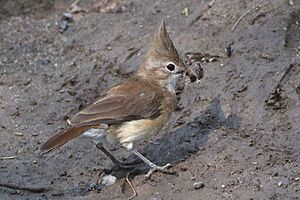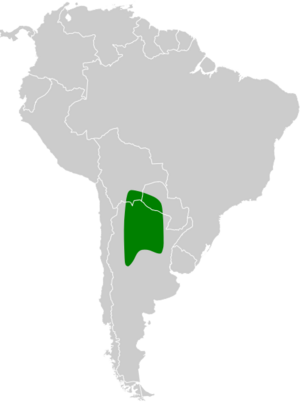Crested hornero facts for kids
Quick facts for kids Crested hornero |
|
|---|---|
 |
|
| Conservation status | |
| Scientific classification | |
| Genus: |
Furnarius
|
| Species: |
cristatus
|
 |
|
The crested hornero (Furnarius cristatus) is a special type of bird known for its unique crest. It belongs to the ovenbird family called Furnariidae. You can find this bird in parts of Argentina, Bolivia, and Paraguay.
Contents
What is the Crested Hornero?
A Unique Bird in its Family
The crested hornero is a small bird, usually about 14 to 15 centimeters (around 5.5 to 6 inches) long. It weighs between 26 and 29 grams (about 1 ounce). This bird has the shortest beak of all the horneros. Its most special feature is the crest on its head, which makes it stand out from other hornero birds.
How to Spot a Crested Hornero
Male and female crested horneros look very similar. They have a light, faint stripe above their eye. Their cheeks and ear feathers are a dull brownish color. The front of their head is reddish-brown, and their crown and crest are a duller clay-brown.
Their back and rump are a dull reddish-brown, and their upper tail feathers are rufous (a reddish-brown color). The two middle feathers of their tail are dull rufous, while the other tail feathers are a brighter rufous. Their wing feathers are mostly dull brownish-red with reddish-brown edges.
The throat of the crested hornero is whitish. Their chest is reddish-brown, and their belly and sides are a deeper reddish-brown with a whitish center. The feathers under their tail are whitish with reddish-brown bases. Their eyes are brownish-red. Their upper beak is blackish, and their lower beak is pinkish with a dark tip. Their legs and feet are gray.
Where Do Crested Horneros Live?
Countries and Habitats
The crested hornero lives in specific areas of South America. You can find them in the very southeastern part of Bolivia and the western part of Paraguay. They also live in Argentina, reaching as far south as the central provinces of San Luis, Córdoba, Santa Fe, and Entre Ríos.
These birds prefer dry places. They live in lowland scrublands, which are areas with low bushes and shrubs. They also inhabit higher elevation Gran Chaco scrub and woodlands. They can be found at altitudes up to 1,000 meters (about 3,300 feet) above sea level.
How Do Crested Horneros Behave?
Staying in One Place
Crested horneros are not migratory birds. This means they stay in the same area all year round and do not travel to different places for seasons.
What Do They Eat?
The main food for crested horneros is arthropods, which include insects and spiders. They usually look for food alone or in pairs. They walk on the ground and pick up their prey.
Building Nests and Raising Young
Crested horneros build their nests during the spring and summer months in the Southern Hemisphere. Scientists believe they are monogamous, meaning a male and female pair stay together for breeding.
Their nests are very interesting! They are shaped like an "oven" and are made of mud. Inside, there is a special chamber lined with dry plant material. These nests are usually built on a horizontal branch of a tree or shrub. A female crested hornero typically lays four eggs. Not much else is known about how they raise their young.
What Do They Sound Like?
The song of the crested hornero is described as a "loud, sharp burst of whistled notes" that gets softer towards the end. Their call sounds like "jwee-t-t-t-t-t-t-t".
Are Crested Horneros Safe?
Conservation Status
The IUCN (International Union for Conservation of Nature) has evaluated the crested hornero and listed it as a species of "Least Concern." This means they are not currently considered to be in danger of extinction.
The crested hornero lives across a fairly large area. Even though we don't know the exact number of these birds, their population is thought to be stable. There are no immediate threats that scientists have found. They are considered to be fairly common or common in their habitat. They also live in at least one protected area. It seems they can even benefit from some changes humans make to their habitat.


